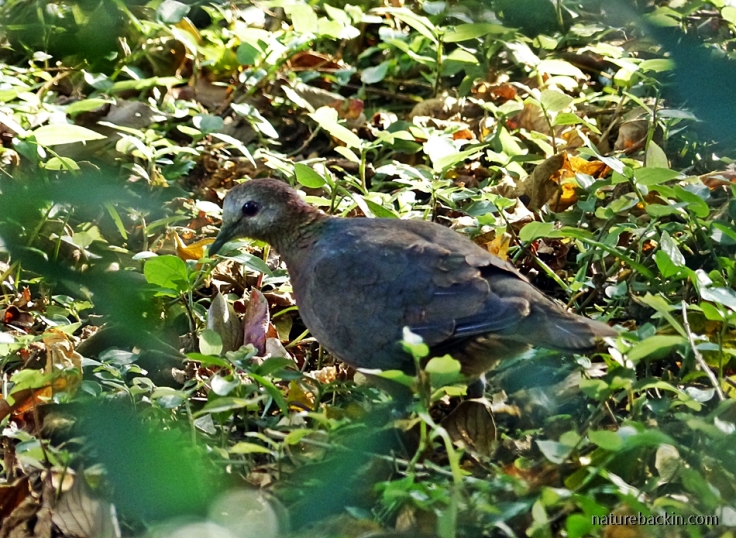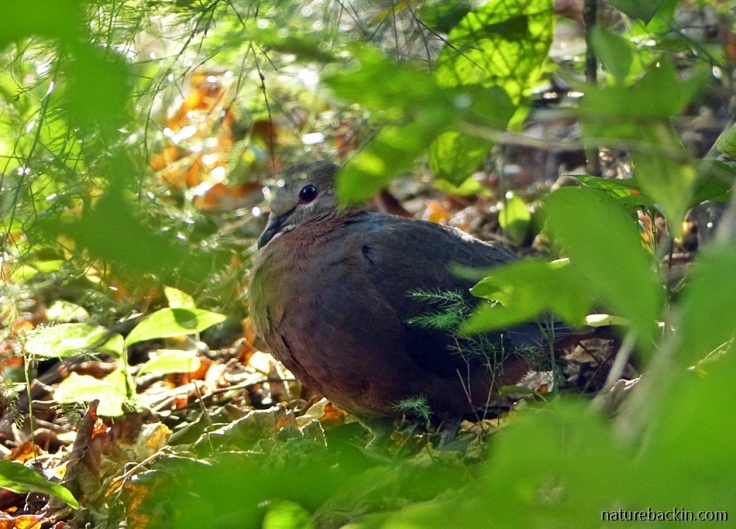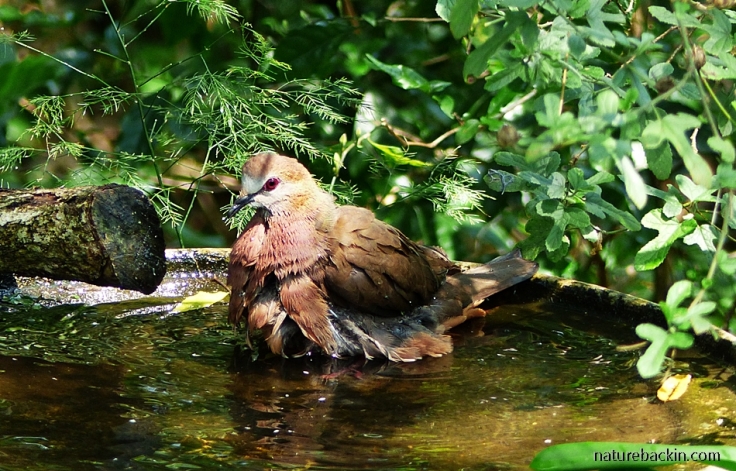Because the Lemon Dove forages discreetly on the ground or in the shrubby understorey it is often overlooked. It occurs in forest habitats and also in gardens that are well wooded.
I was thrilled when I first saw a Lemon Dove in our garden. I kept a look out for it after that, but seldom saw it as it kept well within the undergrowth. After a time, I noticed that one seemed to be hanging out in the mini-woodland section of our garden where it became a little more habituated to our presence. So, one day when gardening in that part of the garden I kept my camera handy and when I thought I saw the dove I crept into the undergrowth and lay down. Just when I was about to give up it started approaching, and through the intervening undergrowth, I managed to take a few photos.

Unaware of my presence, the Lemon Dove was foraging for tiny fallen fruits in the leaf litter

It came really close and for a moment it seemed to acknowledge my presence before turning away to continue in its quest for food
Lemon Doves usually forage singly or in pairs. This spring, a pair of Lemon Doves has started to forage confidently under trees on the edges of our patch of woodland and so relatively out in the open they have been easier to see. Lemon Doves are largish doves, about the size of a Red-eyed Dove. The have a fairly conspicuous pale forehead and face and are cinnamon-coloured on their bellies. The female is slight duller in colour than the male. They are monogamous birds and both parents raise their young together.

For the first time only recently I saw a Lemon Dove perched out in the open while calling its deep repetitive woop-woop call. The call is resonant rather than loud. The previous name for this dove was Cinnamon Dove, descriptive of its cinnamon-coloured belly
Lemon Doves are fairly common in the appropriate habitat, but shrinking forests are a cause for concern. Well-manicured and sterile gardens are unlikely to attract these (and many other) gorgeous birds. If any bird is likely to persuade gardening neat-freaks to loosen up and go a bit wild, surely this lovely bird is a likely persuader? Who would not want to provide a haven for such a creature, given half a chance?

The bird books say that Lemon Doves drink regularly at forest streams, and they also take advantage of any garden bird baths in their territory. However, it was only recently that I saw a Lemon Dove making use of one of our bird baths

Bathing was done thoroughly. On this hot spring day the dove seemed to enjoy the coolness of the water. In between several vigorous dips that soaked its breast feathers, it stayed for several minutes, sometimes preening or scratching, but mostly just cooling off

When it had finished bathing and soaking itself, it flew up onto a low perch and then dropped to the ground and scurried off with the posture of a small quail rather than a rather bulky dove
Lemon Doves are found in forested or wooded habitats in many countries across Sub-Saharan Africa. They mainly eat fruits and seeds, but they also eat snails, termites and other insects, snails, and small bulbs and tubers. I feel very lucky when I see them around.

Sources: Hugh Chittenden, Greg Davies, Ingrid Weiersbye. 2016. Roberts Bird Guide: Illustrating nearly 1,000 Species in Southern Africa (2nd edition). Cape Town: Jacana; Roberts VII Multimedia PC Edition. 1997-2016 Southern African Birding. For details go to http://www.sabirding.co.za/roberts7/portal.html
Posted by Carol









October 15, 2018 at 3:37 am
Beautiful bird and lovely capture. I have often noticed that moving about with camera is very much like meditation. I see so much more, like having an extra pair of ‘eyes’. 🙂
LikeLiked by 1 person
October 16, 2018 at 8:08 am
Thanks Gunta. Yes, the camera does enhance what one sees, but I sometimes think that I need to remind myself to take a step back now and again. I should think that the cathedral-like qualities of the rain forest you visited recently magnified the meditative of experience?
LikeLike
October 16, 2018 at 7:27 pm
My process seems to be to start out ‘stepped back’ and then there are the things that draw me in deeper. Sometimes it seems I capture that feeling in an image and viewing it back home can put me into that meditative experience, at least to a degree. Love the description of the rain forest as cathedral-like. That is so apt. I first experienced what I likened to a religious experience in our Redwood Park. The Olympic rain forest came even closer since we found this less visited spot and had the place pretty much to ourselves. Hard to see wildlife when the racket of civilization intrudes.
LikeLiked by 1 person
October 16, 2018 at 8:04 pm
I really like how your photos show so much detail and texture in the forest. The way you handle the light is amazing. I (and my little camera) battle with the high dynamic range in forests, but if no dappled sunlight, then the light is very low and that presents other problems. Wouldn’t it be nice if the atmosphere of the forest impressed even the noisiest visitors and caused them to pause and experience a moments awe!
LikeLike
October 14, 2018 at 4:41 am
Definitely a plus to have a less manicured garden. I think a little wildness provides habitat for a lot of creatures. I like the lemon dove a lot and, as with most birds, it’s fun to see them bathing.
LikeLiked by 1 person
October 14, 2018 at 4:57 am
Let’s hope a little wildness catches on. It’s interesting to see how different species of birds have different approaches to bathing and drinking.
LikeLiked by 1 person
October 12, 2018 at 2:36 pm
No further excuse is needed not to manicure a garden to ‘perfection’. A really lovely bird.
LikeLiked by 1 person
October 14, 2018 at 4:44 am
Isn’t it nice to have such a lovely excuse? ☺
LikeLike
October 12, 2018 at 6:08 am
What a treat Carol! I love your descrption of lying down to get some of your superb photos, I too often have to lie down to really see and capture our wonderful wildlife!
LikeLiked by 1 person
October 12, 2018 at 6:17 am
Glad to know I am not the only one! Taking photos really has heightened my awareness – even without the camera these days. Do you also find going outside with the camera can be akin to a kind of meditation?
LikeLiked by 1 person
October 12, 2018 at 6:21 am
Absolutely, it can definitely focus my observation, but there are also many times when I purposely don’t take my camera and just am in the moments with my internal ‘memory card’, savouring the sights, smells and sounds!
LikeLiked by 1 person
October 12, 2018 at 6:29 am
That is true. Some of my most intense memories and experiences of nature have been camera free. As you say, it enables one to engage the other senses too and not just focus on the visual. The camera can act as a barrier even though it provides a window.
LikeLiked by 1 person
October 12, 2018 at 5:42 am
Wow! I have only once recorded a Lemon Dove in our garden and that was years ago. Our garden has the right habitat for them – and there may be a pair still – but I fear they may fall prey to the neighbourhood cats. Your pictures are lovely – you are especially fortunate to have witnessed one bathing in your bird bath!
LikeLiked by 1 person
October 12, 2018 at 6:01 am
Hopefully they are ok and just not showing themselves. Yes cats are such a threat to the ground-foraging birds in particular. We keep our cats confined to their own garden, but there are neighbourhood cats out and about.
LikeLike
October 12, 2018 at 5:22 am
What a treasure in your garden! I didn’t know that the name had changed from Cinnamon, so thanks for the update.
LikeLiked by 1 person
October 12, 2018 at 5:50 am
They are a treasure. I so much prefer the old name. I think it was changed to standardise with continent-wide naming.
LikeLike
October 12, 2018 at 5:16 am
I am green with jealousy – You have the coolest bird in your garden, Carol! We have to travel 600+km to get to a reliable spot for seeing Lemon Doves in the wild, and when we do see them they are simply not prepared to pose for a photo. I really enjoyed this post – thank you!
LikeLiked by 1 person
October 12, 2018 at 5:33 am
And I can’t recall seeing them in the wild! I was really chuffed to get some usable photos as they are usually so quick to duck out of sight. Delighted that you also get a kick out of seeing these doves.
LikeLiked by 1 person
October 11, 2018 at 11:58 pm
Reminds me a bit of our Mourning Dove, but this one is equally attractive!
LikeLiked by 1 person
October 12, 2018 at 5:04 am
In my view all doves are lovely ☺
LikeLiked by 1 person
October 12, 2018 at 2:51 pm
That they are.
LikeLiked by 1 person
October 11, 2018 at 10:00 pm
Great profile of this lovely bird!
LikeLiked by 1 person
October 12, 2018 at 4:59 am
Thanks Eliza.
LikeLike